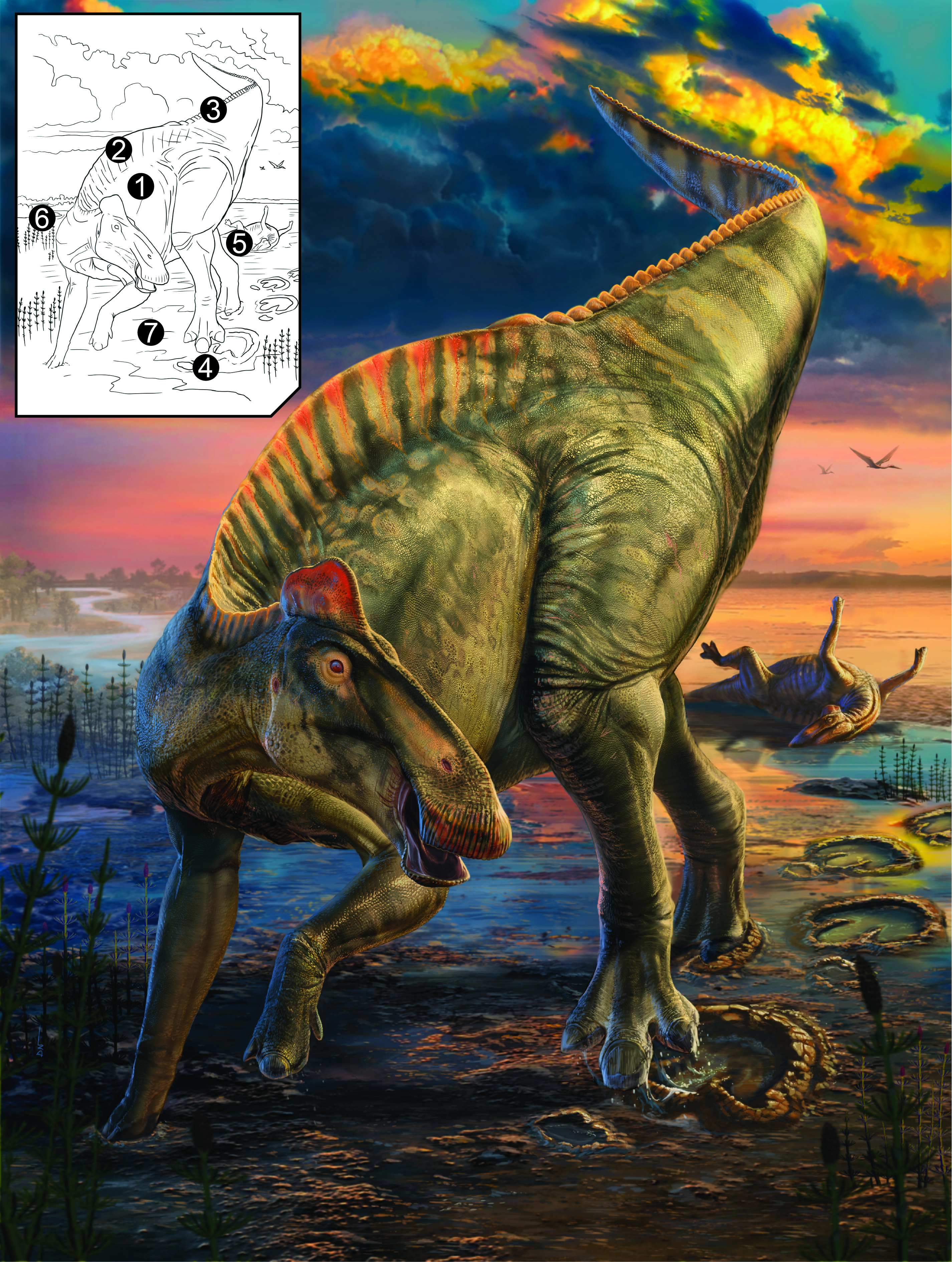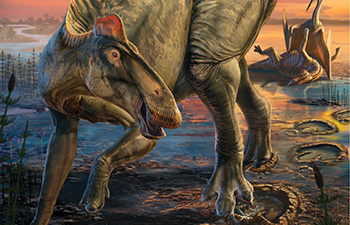
Duck-billed dinosaur ‘mummies’
October 29, 2025
In a new paper in Science, Paul Sereno and a multidisciplinary team describe how 66-million-year-old carcasses of the end-Cretaceous duck-billed dinosaur Edmontosaurus annectens were transformed into "mummies" preserving scales, crests and hooves. Read more.
Learn MoreThe 6,000 square foot facility will feature fossil preparation space, multipurpose areas for community programs, and tons of specimens collected from Sereno’s worldwide expeditions. Soon, South Side residents won’t have to travel to the Field Museum to see a Tyrannosaurus rex skeleton—there will be one in their own backyard. Paleontologist Paul Sereno’s Fossil Lab at the University of Chicago is moving to the center of the Washington Park Read More.
Learn More
The swimming abilities of the massive predator and fan-favorite, Spinosaurus, have been hotly debated.
Using CT scans of fossils to make a virtual skeleton and adding flesh to create a model, our most recent publication concludes Spinosaurus did indeed inhabit shorelines with many adaptations for life at water’s edge, but would fail miserably as a fully aquatic, agile underwater predator.
Read More.

Get a whole new dinosaur experience with Dinosaurs of the Sahara, the lost world of African dinosaurs, debuting for the first time at the Cleveland Great Lakes Science Center on Friday May 26 and running through Monday September 4. Dinosaurs of the Sahara brings the unique world of African dinosaurs to life with original fossils from the Sahara, one-of-a- kind...
Learn More
New dinosaurs by the dozen fill two large shipping containers poised to depart Niger for Africa’s coast and then travel by ship across the Atlantic destined for my Fossil Lab at the University of Chicago, where a process of cleaning and recomposing bones over the coming years...
Learn More
JENGUEBI, NIGER – Seas of sand form the core of the Sahara, the world’s largest desert. Our expedition caravan wound slowly between dunes, probing for terrain hard enough to get us to our end goal —windswept rock with fossils from the youngest part of the dinosaur era on Africa some 90 million years ago. Exposed as isolated patches, the target areas resemble an oceanic island chain, each patch decreasing in size until disappearing altogether under the sand seas. Read More
Learn More
Was Spinosaurus a diving hunter? UChicago paleontologists and colleagues unearth an array of new evidence that suggests the sail-backed giant was far too land-adapted to function even as a slow underwater predator.
Learn More
TCHINEKANKARAM, NIGER — One mile long, rising as barren rock no more than 10 feet above a parched plain of patchy grass and thorny acacia, is an area known as Tchinekankaran (chin-kan-karan), or “place of insects” in Tamasheq, the language of Tuareg nomads. True to its name, voracious scorpions wind spiders and praying mantises dueled under our camp lights, but we came for the sea of fossil bones peeking from rocks nearby. Read More

Dispatch No. 2 Live from the Field:
Petrified tree trunks jut from the desert floor, and fossil jaws and bones of nameless beasts peek out from a barren landscape. Nomad legend describes it as “The place where camels fear to go.” Called Gadoufaoua (Ga-doo-fawa) by French geologists who visited in the 1950s, this 100-mile stretch of the Sahara comprises the richest dinosaur beds on the continent. Read More.

AGADEZ, NIGER — Before COVID-19 shut down travel, I led expeditions that discovered some 25 tons of rare fossils scattered across the Sahara Desert, in remote areas of the West African country of Niger.
Read More.

For 3 months this Fall, Paul and his team of 20 will excavate some 25 tons of dinosaurs and ancient humans in the heart of the Sahara, a feat never before attempted. These fossils add to Africa’s world-class heritage.
Read more at the Chicago Tribune!
Learn more about the 2022 Expedition.
Thanks to expedition sponsor Andera equipment

NIAMEY, Niger — In secret patches of the south-central Sahara, blankets of sand hide 20 tons of dinosaur bones.
There are flying reptiles. A creature that resembles an armored dog. Eleven species yet to be identified — all with long necks. They roamed the desert when it was still green, scientists concluded, as far back as 200 million years ago.
Learn More
Predators abound on land, in the air and in water some 95 million years on the shores of northern Africa —as shown by the abundant fossils in the Kem Kem region. Large herbivores, such as the long-necked sauropod Rebbachisaurus, could have been hunted or scavenged by several large predators. Artwork by Davide Bonadonna.
New fossils of the huge Cretaceous-era predator, Spinosaurus, reveal it adapted to life in water some 95 million years ago, providing the most compelling evidence to date of a dinosaur able to live and hunt in an aquatic environment. An international team based at the University of Chicago built a CT-based digital model of the 50-foot long dinosaur to understand its anatomy and capabilities.
Learn More
“More than 100 human burials lay before me” stammered Paul Sereno, paleontologist at the University of Chicago and Explorer-in-Residence at National Geographic.
Sereno had just discovered the Sahara’s largest graveyard—hundreds of burials older than the pyramids.
Read more about Skeletons of the Sahara on PBS or get your own copy!
Learn MoreSereno kicks off the Festival's Hyde Park Day with an illustrated discussion of the latest findings in his field, in a program appropriate for both children and adults.
Learn More
Paul Sereno's Fossil Lab is located at the University of Chicago in Hyde Park. It is comprised of a prep lab, fossil storage areas, teaching space, molding and casting room, bug room, and houses part of the University of Chicago Research Collection.
Learn MorePaul Sereno participates in Google Science Fair 2013 in a Hangout On Air answering questions about his discoveries and what it is like to be a paleontologist.
Learn MoreGo behind the scenes and hear National Geographic Explorer-in-Residence Paul Sereno talk about his decision to become a paleontologist and his most memorable discoveries.
Learn MoreNational Geographic Live! Extreme Dinosaurs
Hear about one of the most bizarre dinosaurs ever uncovered from its discoverer, acclaimed paleontologist and National Geographic Explorer-in-Residence Paul Sereno.
Learn MorePaul Sereno teaches the world about its evolutionary past through what he calls "adventure with a purpose." His travels have brought him to discover important links in the evolution of life on earth such as his discovery of the world's largest crocodile.
Learn MorePaul Sereno talks about Eodromaeus the "Dawn Runner"
Learn MorePaul Sereno describes Raptorex - a new dinosaur that show how the body plan of Tyrannosaurus rex evolved at 1/100th the size.
Learn MoreWhat can fossils teach us?
Strange landscapes, scorching heat and (sometimes) mad crocodiles await scientists seeking clues to evolution's genius. Paleontologist Paul Sereno talks about his surprising encounters with prehistory -- and a new way to help students join the adventure.
Learn More
Dr. Paul Sereno posing with the skull of Sarcosuchus imperator. This amazing 40 foot long crocodile was the subject of the National Geographic film 'When Crocs Ate Dinosaurs.'
Nicknamed “SuperCroc,” the animal is believed to have reached 40 feet (12 meters) in length—the length of a city bus—making it one of the largest crocs that ever lived. SuperCroc lived alongside dinosaurs, perhaps feasting on them.
Learn More

























Written by Paul Sereno & Paul Rand || July 15, 2019
Written by Paul Sereno || September 6, 2001
Written by Paul Sereno || September 6, 2001
Written by Paul Sereno || October 3, 2000
Written by Paul Sereno || September 19, 2000



